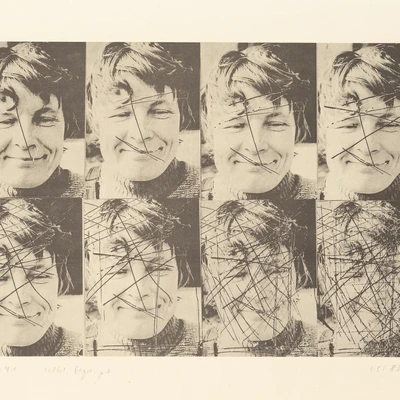Armin Münch
- * 1930
- † 2013
Life dates
- Artist
Category
Man and the Sea
The sea played a very special role in the life and work of graphic artist and draughtsman Armin Münch. He chose the Baltic Sea as his home and the water inspired many of his art works.
Münch was born on 1 May 1930 in Rabenau, a small city in Saxony. He developed an affinity for drawing even as a child. In the nearby Dresden, he was witness to the fire bombings of 1945. His early experiences of the Nazi period and the war had a lifelong impact on him. He formulated his humanist approach later in works such as Atompilz (Mushroom Cloud, from 1957) and Panzerauto (Tank Car, from 1973). In 1962, he noted despairingly in his journal: “Danger of a new world war, a nuclear war”.
Armin Münch, after graduating from high school, initially worked and trained as a graphic draughtsman at the Sachsenverlag in Dresden, but was able to commence his studies at the Hochschule der bildenden Künste in Dresden as early as 1950. Thereafter, in 1955, he followed his longing for the sea and chose Rostock as his new home. “A view of the port and a sandy road along the beach. What happiness!”, he writes in his diary. From 1958 to 1960, he was a masters fellow with Hans Theo Richter, Max Schwimmer and Josef Hegenbarth at the German Akademie der Künste in Berlin. Münch’s work reveals something of the lightness evident in the drawing style of these fellow artists – look, for instance, at his Selbstbildnis (Self-Portrait) from 1963 or his Liebespaar – Glück (Lovers – Happiness) from 1973.
Münch worked for only ten years, from 1960 to 1970, exclusively as an independent artist. Thereafter, he was employed in art education, while continuing to create new art works. He taught starting in 1970 at the Kunsthochschule Berlin-Weissensee, and from 1976 through 2000 was employed as a regular Professor, moving from the University of Greifswald to the University of Rostock in 1991. In addition, he was, starting in 1995, a member of the board of examiners of the private art academy Kunsthochschule Bochum. Despite the demands of teaching, however, Münch continued to find time for research voyages inter alia to Russia, Siberia, Georgia, Armenia, Tajikistan, Rumania, Belgium, Poland, and Switzerland, as well as for his own artistic projects, which were often influenced by these travels. The sea and literature also inspired numerous works in Münch, who was a sensitive observer of the world around him. He created significant cycles of illustrations for literary works, in which the sea and the oceans played a role: Herman Melville’s Moby Dick, Ernest Hemingway’s The Old Man and the Sea, the legend of the pirate Klaus Störtebeker, and Franz Fühmann’s Böhmen am Meer (The Bohemian Sea). He consecrated a series of illustrations to the relationship between Faust and Mephisto, to Thomas Mann’s novel Joseph und seine Brüder (Joseph and his Brothers), to the Bauernkrieg (The German Peasants’ War) and the Battle of Stalingrad. His preferred media were drawing, lithography, and the woodcut. “The frankness and immediacy [of Armin Münch’s work], his concentration on the essential, his deeply poetic underlying tone make him a paragon of artistic Realism, one who, in ever evolving artistic forms, lends shape to the breadth and diversity of life” – thus wrote Hannelore Gärtner in praise of the artist in 1966 in the magazine Bildende Kunst.
Münch bequeathed a significant part of his life work – ca. 15 000 drawings, graphic art works, and sketchbooks – to the University of Rostock. Another part of his legacy went to the Pommersches Landesmuseum Greifswald. Armin Münch died on 21 August 2013 in Rostock.
text: Matthias Zwarg, translation: Darrell Wilkins
Works by Armin Münch
Travelling exhibition
Publik machen: 40 Künstler:innen aus dem Bestand des Zentrums für Kunstausstellungen der DDR
Popular keywords
Many more works are hidden behind these terms
